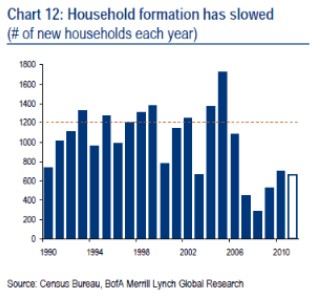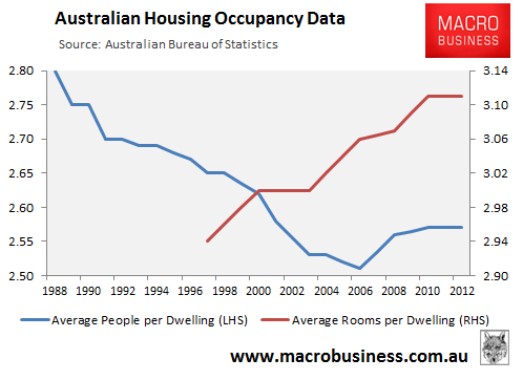
Business Spectator’s Robb Burgess posted an interesting article over the weekend describing how Australia’s perceived housing shortage could turn into a “surplus”, given the large number of rooms sitting idle across Australia:
One of the interesting things about the past two decades of Australian social history is [that]… we’ve been building bigger houses, and fewer people have been living in each one.
…the number of persons per household fell until the start of the GFC, and has risen slightly since then. My guess is that a combination of welfare cuts and reduced hours of work will push more people back into accommodation arrangements that, in better times, they’d prefer not to endure…
There are many options for filling some of them [i.e. empty bedrooms]. Adult children might move back in with their parents. Friends might house-share rather than have their own place. Childless couples might share a home. Whole families might share homes.
The number of hived-off granny flats, bedsits and lodging rooms offered for rent may also increase…
Whichever of these predominates – and given that dole cuts will impact the young most, it will be that age group on the move first – the net effect is the same. A housing shortage could quickly become a housing surplus…
For the owners of all those new bedrooms, the message from the market could be “not now dear – you’ve got a headache”.
Burgess’ argument is spot on. An interesting aspect of the US housing market is that underlying demand was running strong in the years leading-up to the bust. Unemployment was low, the US economy was powering, credit was readily available, and a record 1.7 million households were formed in 2005 – 500,000 more than the long-run average of 1.2 million household formations per year.
The surge in household formations led to numerous suggestions that the US was facing a housing shortgage, especially in areas where strict land-use regulations were in effect, such as California.
The rest, of course, is history. The US housing bubble popped, the economy tanked, and the rate of household formation fell to around half the long-run average (see below chart), leaving a vast oversupply of homes, even in severely supply-restricted markets like coastal California.

The key lesson from the US experience is that the demand for housing is highly changeable depending, largely, on prevailing economic conditions. And while Australia is in some respects fortunate that it has not experienced the types of over-building experienced in some other nations, as argued by Burgess, it could equally be argued that there is significant latent capacity (excess bedrooms) in the pre-existing housing stock versus persons per dwelling (see next chart).

Indeed, basic economics also tells us that policies that restrict housing supply steepens the supply curve, which makes house prices far more sensitive to changes in demand and increases the likelihood of the housing market experiencing boom/bust price cycles as demand rises/falls.
This is a topic that I have written about many times before, for example here and here. It is also a view supported by extensive research, particularly in the US.
For example, a Journal of Urban Economics paper by Haifang Huanga and Yao Tang suggests the link between higher house price volatility and non-responsive housing supply (e.g. due to restrictive land use regulations) has become more pronounced in the US [my emphasis]:
Abstract: “In a sample covering more than 300 cities in the US from January 2000 to July 2009, we find that more restrictive residential land use regulations and geographic land constraints are linked to larger booms and busts in housing prices. The natural and man-made constraints also amplify price responses to the subprime mortgage credit expansion during the decade, leading to greater price increases in the boom and subsequently bigger losses.
And in a detailed examination of studies in this area, Harvard’s Edward Glaeser and Warton’s Joseph Gyourko also concluded that tight land/housing supply leads to greater price booms and busts:
Recent research also indicates that house prices are more volatile, not just higher, in tightly regulated markets …. price bubbles are more likely to form in tightly regulated places, because the inelastic supply conditions that are created in part from strict local land-use regulation are an important factor in supporting ever larger price increases whenever demand is increasing.
…. It is more difficult for house prices to become too disconnected from their fundamental production costs in lightly regulated markets because significant new supply quickly dampens prices, thereby busting any illusions market participants might have about the potential for ever larger price increases.
The key take away is that should economic conditions deteriorate significantly, such as through a disorderly unwinding of the mining boom, the number of Australians opting for group accommodation (or the number of young people moving back into mum and dad’s) could rise significantly, turning a perceived housing shortage into a surplus. This situation would be exacerbated if the economic slowdown also resulted in a material fall in net migration into Australia, as typically occurs during downturns.

